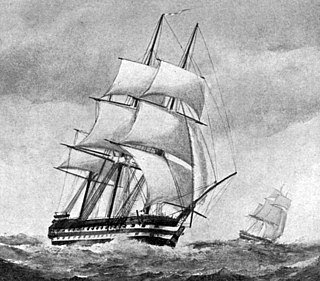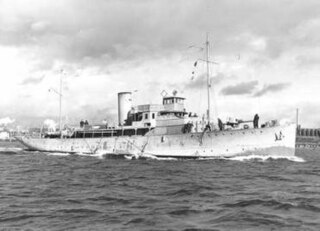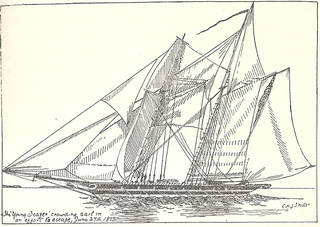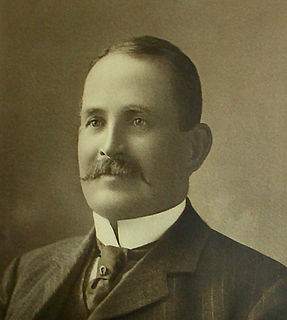
Swan Hunter, formerly known as Swan Hunter & Wigham Richardson, is a shipbuilding design, engineering, and management company, based in Wallsend, Tyne and Wear, England.

HMS Wellington is a Grimsby-class sloop, formerly of the Royal Navy. During the Second World War, she served as a convoy escort ship in the North Atlantic. She is now moored alongside the Victoria Embankment, at Temple Pier, on the River Thames in London, England, as the headquarters ship of the Honourable Company of Master Mariners, where she is known as HQS Wellington. It was always the ambition of the founding members of the company to have a livery hall. Up to the outbreak of war in 1939, various proposals were examined, including the purchase of a sailing ship, Archibald Russell.
Furness Withy was a major British transport business. It was listed on the London Stock Exchange.

HMS Donegal was a 101-gun screw-driven first-rate ship of the line of the Royal Navy, launched on 23 September 1858 at Devonport Dockyard.

HMCS Elk was an armed yacht serving with the Royal Canadian Navy during the Second World War. Prior to Canadian service, the ship was named Arcadia. She was used initially as a patrol vessel, but later saw use as a training and guard ship for submarines on the East Coast of Canada. Following the war, Elk was sold for commercial use and returned to her original name. She was renamed Grand Manan III in 1946 and used as a short-haul passenger ferry before being broken up in 1968.

HMS Prince of Orange was a 70-gun third rate ship of the line of the Royal Navy, built to the 1719 Establishment at Deptford Dockyard, and launched on 5 September 1734.

Young Teazer was a United States privateer schooner that captured 12 British vessels, five of which made it to American ports. A member of her crew blew her up at Mahone Bay, Nova Scotia during the War of 1812 after a series of British warships chased her and after HMS Hogue trapped her. The schooner became famous for the deadly explosion that killed most of her crew and for the folklore about the ghostly "Teazer Light."
HMS Halifax was a ship-rigged sloop of the Merlin class built in 1806 for the British Royal Navy at the Naval Yard in Halifax, Nova Scotia. Built to fill a pressing need for coastal patrol sloops on the North American Station, Halifax was one of the few warships built at Halifax Naval Yard in the Age of Sail as the yard's primary function was supply and refit.

The Bridgewater-class sloop was a class composed of two sloops built for the Royal Navy, HMS Bridgewater and HMS Sandwich. The ships were part of the Royal Navy's 1927 Build Programme as replacements for the Flower-class sloop.

RMS Corfu was a Royal Mail Ship and ocean liner operated by the Peninsular and Oriental Steam Navigation Company. Known as one of the 'Far East Sisters', she was launched in 1931 to serve the company's India and Far East Mail Service, along with her sister ship, the RMS Carthage. Both ships were built by Alexander Stephen & Sons Ltd in Glasgow, Scotland and served from 1931 until 1961 when they were scrapped in Japan.

The Battle off Halifax took place on 28 May 1782 during the American Revolutionary War. It involved the American privateer Jack and the 14-gun Royal Naval brig HMS Observer off Halifax, Nova Scotia. Captain David Ropes commanded Jack, and Lieutenant John Crymes commanded Observer. The battle was "a long and severe engagement."
Canada may refer to a number of ships

George Henry Wright was a significant business man and philanthropist in Halifax, Nova Scotia. He was born at Wright's Cove, Nova Scotia and died in the sinking of the Titanic at the age of 63. He established Write's World Business Directory in Boston and later returned to Halifax and invested in the city. His own house at 989 Young Ave, and two of his public buildings, the Marble Wright Building and The Saint Paul Building, still stand in downtown Halifax. They were all built by architect James Charles Philip Dumaresq.

HMCS Wentworth was a River-class frigate that served with the Royal Canadian Navy during the Second World War. She served primarily as a convoy escort in the Battle of the Atlantic. She was named in honour of the town of Dartmouth, Nova Scotia. She could not be named HMCS Dartmouth for fear of confusion with HMS Dartmouth, and so was named after a famous early resident, Nova Scotia Lieutenant Governor Sir John Wentworth. Her name is often mistakenly associated with Wentworth County, Ontario, in honour of the city of Hamilton.
HMS Thyme was a Flower-class corvette which served in the Royal Navy during the Second World War. Laid down by Smiths Dock Company in April 1941, She was launched in July 1941, and commissioned in October 1941.

RMS Otranto was an ocean liner that was built for the Orient Steam Navigation Company in 1925. The "RMS" prefix stands for Royal Mail Ship, as she carried overseas mail under a contract between Orient Line and Royal Mail. Otranto was in service until 1957, when she was sold for scrap.
HMS Blonde was a 32-gun fifth rate warship of the British Royal Navy captured from the French in 1760. The ship wrecked on Blonde Rock with American prisoners on board. An American privateer Captain Daniel Adams rescued the American prisoners and let the British go free. The Captain's decision created an international stir. Upon returning to Boston, the American privateer was banished for letting go the British crew and he and his family became Loyalist refugees in Nova Scotia.












